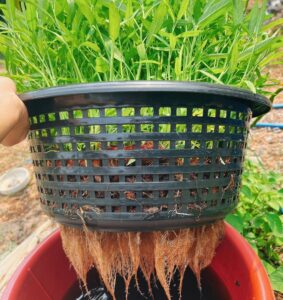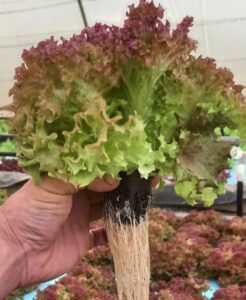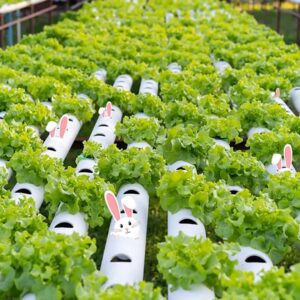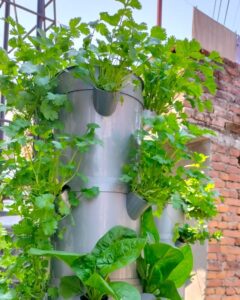How to start a hydroponic farm? Hydroponic farming is a method of growing plants without soil, where the plants are grown in a nutrient-rich water solution.
This technique is gaining popularity due to its various benefits, such as increased yield, faster growth, and efficient use of resources like water and space.
However, before starting a hydroponic farm, it’s important to understand the basics of hydroponics, such as the different types of hydroponic systems, nutrient management, and pest control.
By understanding these fundamentals, you can ensure a successful and sustainable hydroponic farm.
In this article, we will provide a step-by-step guide on how to start a hydroponic farm, including planning, building the hydroponic system, preparing the growing environment, planting and maintaining the hydroponic farm, and marketing your products.
Starting a Hydroponics Farm
If you are interested in starting a hydroponic farm, here is everything you need to know;
Choosing a Location
The first step in starting a hydroponic farm is to choose an appropriate location. Ideally, the location should have access to natural light, water, and electricity. Indoor hydroponic farms can be set up in unused spaces such as basements, garages, or warehouses.
Outdoor hydroponic farms can be established on rooftops, balconies, or unused land. Ideally, the location should have good drainage, be sheltered from extreme weather conditions, and have adequate space for your hydroponic system.
Setting up the Infrastructure
Once you have chosen a location, the next step is to set up the infrastructure for your hydroponic farm. This includes building a greenhouse or other enclosed structure to protect plants from pests, weather, and other environmental factors.
Depending on your hydroponic system, you may need to invest in a greenhouse, grow lights, irrigation system, and other equipment. It’s important to carefully consider your budget and choose equipment that fits your needs and goals.
You’ll also need to install an irrigation system, lighting, and temperature control systems to create optimal crop-growing conditions.
Selecting the Right Plants to Grow
One of the advantages of hydroponic farming is that you can grow various plants, including fruits, vegetables, and herbs. When selecting the right plants to grow, consider factors such as market demand, growth rate, and the climate of your location. Leafy greens, tomatoes, peppers, and herbs are popular choices for hydroponic farming.
By carefully selecting your location, setting up the infrastructure, and selecting the right plants to grow, you can lay a solid foundation for your hydroponic farm. The next section will explore the steps involved in building a hydroponic system.
When selecting the plants to grow on your hydroponic farm, consider factors such as the climate, local demand, and the specific requirements of each crop.
Some popular hydroponic crops include lettuce, herbs, tomatoes, peppers, and strawberries. Choose plants that are well-suited to hydroponic growing conditions and have a high market value to ensure the success of your farm.
By carefully selecting your location, setting up the necessary infrastructure, and choosing the right plants to grow, you can create a solid foundation for your hydroponic farm. Some believe hydroponics are organic means of growing plants and herbs; we wrote an extensive guide on it here.

Hydroponic farming requirements
Hydroponic farming has become increasingly popular in recent years, as it allows for efficient, year-round production of crops in controlled environments. However, several requirements must be met to grow plants using hydroponics successfully.
- Growing Environment: A suitable growing environment is the first requirement for hydroponic farming. This includes a controlled space, such as a greenhouse or indoor facility, with adequate lighting, temperature, humidity, and air circulation. The growing environment must also be free from pests and diseases that could harm the plants.
- Growing System: The second requirement is a suitable growing system. Several types of hydroponic growing systems exist, including deep water culture, nutrient film technique, and drip irrigation. Each system has its own water and nutrient delivery requirements, monitoring and controlling pH and nutrient levels.
- Water Quality: The third requirement is high-quality water. Since hydroponic systems rely on water to deliver nutrients to plants, it is important that the water be free from contaminants and have the proper pH level. Some growers use reverse osmosis or other water treatment systems to ensure the purity of the water.
- Nutrient Solution: The fourth requirement is a balanced nutrient solution. Hydroponic plants require a specific balance of nutrients, including nitrogen, phosphorus, potassium, calcium, and magnesium, as well as trace elements like iron and manganese. The nutrient solution must be carefully monitored and adjusted to ensure that the plants receive the proper balance of nutrients.
- Monitoring and Maintenance: The final requirement is ongoing monitoring and maintenance of the hydroponic system. This regularly includes testing water and nutrient levels, cleaning and disinfecting the growing system, and adjusting the growing environment as needed.
Hydroponic farming requires a suitable growing environment, a suitable growing system, high-quality water, a balanced nutrient solution, and ongoing monitoring and maintenance. By meeting these requirements, growers can produce high-quality crops using hydroponics.
Hydroponic System Options
There are several types of hydroponic systems, each with unique characteristics and advantages. Here are some of the most common types:
- Deep Water Culture (DWC): In a DWC system, plants are suspended in a nutrient-rich water solution, with their roots submerged in the water. Oxygen is supplied through an air stone or diffuser to prevent the roots from drowning.
- Drip System: In a drip system, the nutrient solution is pumped through tubes to individual plants or groups of plants, delivering a precise amount of nutrients to each plant.
- Ebb and Flow: In an ebb and flow system, plants are placed in a container filled with a growing medium, such as gravel or rock wool. The container is flooded with nutrient solution, draining away, providing a cycle of wet and dry periods.
- Nutrient Film Technique (NFT): In an NFT system, the nutrient solution flows through a shallow channel, with plants growing in holes or baskets above the channel. The roots are exposed to the nutrient solution constantly flowing past them.
Each hydroponic system type has its own advantages and disadvantages. For example, DWC systems are simple and inexpensive to set up but may require more frequent maintenance to ensure adequate oxygen supply.
Drip systems offer precise nutrient delivery but can be prone to clogging. Ebb and flow systems are versatile and easy to use but require careful monitoring to avoid over- or under-watering. NFT systems offer excellent nutrient delivery but can be more complex to set up.
Choosing the Right System for Your Farm
When choosing the right hydroponic system for your farm, consider factors such as your budget, space requirements, and the specific needs of your crops.
Research each system type thoroughly and weigh the pros and cons before deciding. Be sure to choose a system that is reliable, efficient, and suited to your individual needs.
By selecting the right hydroponic system for your farm, you can create a sustainable, high-yield growing environment for your crops. The next section will explore how to prepare your hydroponic system for planting.

Building the Hydroponic System
There are several types of hydroponic systems, each with its advantages and disadvantages. Some of the most common types include deep water culture, nutrient film technique, drip irrigation, and ebb and flow systems.
When selecting the type of hydroponic system for your farm, consider the size and space available, the type of crops you’ll be growing, and your budget. Deepwater culture systems are simple and easy to set up, making them ideal for beginners.
In contrast, nutrient film techniques and drip irrigation systems are more complex but offer greater control over nutrient delivery and water usage.
Once you’ve decided on the type of hydroponic system to use, it’s time to purchase the necessary materials. This may include containers, pumps, tubing, grow lights, and a nutrient solution. Be sure to source high-quality materials designed for hydroponic use to ensure the success of your farm.
Building and Installing the Hydroponic System
- Choose the type of hydroponic system you want to build: There are several types of hydroponic systems available, such as deep water culture, nutrient film technique, drip system, and ebb and flow system. Choose the one that suits your needs and budget.
- Gather the materials: You will need a container or a reservoir to hold water, net pots, growing medium, nutrient solution, air pump, air stone, tubing, and pH meter.
- Prepare the container: Clean the container thoroughly and fill it with water. Adjust the pH level of the water to the desired level using a pH meter. Most plants grow well in a pH range of 5.5 to 6.5.
- Install the air pump and air stone: The air pump and air stone will provide oxygen to the roots of the plants. Attach the air stone to the tubing and place it at the bottom of the container. Connect the other end of the tubing to the air pump and turn it on.
- Add the growing medium and net pots: Fill the net pots with the growing medium, such as coconut coir, perlite, or vermiculite. Place the net pots in the container, submerging the plant’s roots in the nutrient solution.
- Add the nutrient solution: Mix the solution according to the instructions provided by the manufacturer. Pour the solution into the container, ensuring the level is high enough to reach the roots of the plants.
- Monitor and maintain the system: Regularly check the solution’s pH and nutrient concentrations. Adjust them as needed. Keep an eye on the air pump and air stone to ensure they work properly. Also, remove any dead or dying plants from the system.
- Harvest the plants: Depending on the type of plants you are growing, you can harvest them when they are mature. Make sure to rinse them thoroughly before consuming them.
With a little effort and care, you can build your hydroponic system and enjoy fresh and healthy produce all year round.
Building and installing your hydroponic system requires basic DIY skills and tools. Follow the manufacturer’s instructions carefully to ensure that your system is set up correctly.
Be sure to test the system thoroughly before planting your crops to ensure everything works as it should.
By carefully choosing the type of hydroponic system to use, sourcing high-quality materials, and following the manufacturer’s instructions, you can create a reliable and effective hydroponic system for your farm.
Preparing the Growing Environment
Preparing the growing environment is a crucial step in hydroponics as it directly affects the growth and health of your plants. Here are some steps to prepare for the growing environment in hydroponics:
- Choose a suitable location: Select a location that receives adequate sunlight or artificial lighting and is well-ventilated. Avoid placing your hydroponic system in areas with extreme temperatures, such as near heating or cooling vents.
- Preparing the Growing Area: Before planting, prepare the growing area by cleaning and sanitizing all equipment and surfaces. Ensure that your hydroponic system is working properly and that your nutrient solution is mixed according to manufacturer instructions.
- Set up your hydroponic system: Follow the instructions provided by the manufacturer to set up your hydroponic system. Ensure that it is stable and secure before adding plants.
- Select the growing medium: Hydroponic systems do not use soil, so you will need to choose a growing medium. Some common growing mediums include coconut coir, rockwool, perlite, and vermiculite.
- Choosing the Right Crops to Grow: When selecting crops for your hydroponic farm, consider climate, space requirements, and market demand. Leafy greens such as lettuce, kale, and spinach are popular choices for hydroponic farming, as they grow quickly and can be harvested multiple times.
- Setting up a Nutrient Solution and pH Monitoring System: Maintaining the correct nutrient solution and pH levels is crucial for the success of your hydroponic farm. Purchase a reliable pH monitoring system and regularly test your nutrient solution to ensure it remains within the optimal range for your crops.
- Monitor pH and nutrient levels: Use a pH meter to monitor your nutrient solution’s pH level regularly. Most plants grow best in a pH range of 5.5 to 6.5. Additionally, monitor the nutrient levels and adjust them as needed.
- Installing Lighting and Temperature Control Systems: Consider installing a lighting and temperature control system in your hydroponic farm to optimize plant growth. LED grow lights are a popular choice for indoor hydroponic farming, as they are energy-efficient and can be customized to suit different crops. Temperature control systems can help maintain a stable growing environment, especially in areas with fluctuating temperatures. Adjust the distance between the lights and plants to prevent heat damage.
- Control humidity and temperature: Maintain a suitable temperature and humidity level to prevent the growth of mold and mildew. The ideal temperature range for most hydroponic plants is between 65°F and 80°F, and the ideal humidity range is between 50% and 70%.
- Monitor plant growth: Keep a close eye on your plants to detect any signs of disease or nutrient deficiencies. Remove any dead or dying plants from the system immediately to prevent the spread of disease.

By following these steps, you can prepare an ideal growing environment in hydroponics that will help your plants thrive and produce a healthy harvest.
By selecting the right crops, preparing your growing area, monitoring your nutrient solution and pH levels, and installing appropriate lighting and temperature control systems, you can create an optimal growing environment for your hydroponic farm.
Plant Nutrition
In hydroponic farming, plants receive their nutrients directly from the nutrient solution rather than from the soil. Therefore, ensuring that the nutrient solution contains all the necessary elements for healthy plant growth is crucial.
Types of Plant Nutrients
Plants require various nutrients to grow adequately. However, The three primary macronutrients plants require are nitrogen, phosphorus, and potassium (NPK).
Other essential elements include calcium, magnesium, sulfur, iron, and trace minerals such as zinc and copper. These nutrients can be supplied in a hydroponic system as fertilizers are added to the water solution.
One of the benefits of hydroponics is that it allows for precise control of nutrient levels. This means that plants can receive the exact amount of nutrients they need for optimal growth, and excess nutrients can be avoided, which can lead to problems such as nutrient burn.
In addition to the essential nutrients, plants also require trace elements, such as iron, manganese, and zinc. These elements are typically provided in hydroponic systems as chelated micronutrient solutions, which help ensure that the trace elements are available to the plants.
Ways to add nutrients
There are several ways to add nutrients to a hydroponic system, including:
- Pre-made nutrient solutions: These commercially available nutrient solutions are formulated specifically for hydroponic systems. They typically come in two or three parts, and the user can mix the parts together in the correct ratios to create a complete nutrient solution.
- Individual nutrient salts: Instead of using pre-made nutrient solutions, individual nutrient salts can be purchased and mixed together in the correct ratios to create a custom nutrient solution. This method allows for greater control over the specific nutrient levels in the solution. However, in the case of salt buildup, here is how to clean it.
- Organic nutrients: Some hydroponic growers prefer to use organic nutrient sources, such as fish emulsion, seaweed extract, or compost tea. These organic sources can be added to the water solution to provide the necessary nutrients for plant growth.
As for where to get these nutrients, many hydroponic supply stores sell nutrient solutions and individual nutrient salts. Some garden centers may also carry hydroponic supplies, or they may be available for purchase online. Organic nutrient sources can often be found at health food stores or gardening centers.
It’s important to choose high-quality nutrient sources and to follow the manufacturer’s instructions or guidelines for mixing and application.
Overdosing or underdosing nutrients can lead to problems, so monitoring nutrient levels and adjusting as needed is important.
Maintaining Nutrient Levels in Your System
Maintaining the proper nutrient balance in your hydroponic system is essential for the health and productivity of your crops.
Regularly test your nutrient solution and adjust the nutrient levels as needed to ensure they remain within the optimal range for your crops. Consider using organic fertilizers or supplements to improve the nutrient content of your solution.
In addition to maintaining proper nutrient levels, monitoring pH levels and ensuring that they remain within the optimal range for your crops is important.
pH levels can affect the availability of nutrients in the solution, so it is important to test and adjust them regularly.
By understanding the importance of plant nutrients in hydroponic farming, knowing the types of plant nutrients, and maintaining nutrient levels in your system, you can create a healthy and productive growing environment for your crops. In the next section, we’ll explore some tips for maintaining your hydroponic system and ensuring the health and productivity of your crops.

Planting and Maintaining the Hydroponic Farm
Planting Seedlings or Germinating Seeds
When planting your hydroponic farm, you can use seedlings or germinate seeds. Seedlings are typically easier to grow and offer a faster harvest time while germinating seeds require more time and attention but can offer a wider variety of crops.
Whichever method you choose, handle the plants carefully and avoid damaging the roots.
Managing the Nutrient Solution and pH Levels
Regularly monitor and adjust your hydroponic system’s nutrient solution and pH levels to ensure your plants receive the nutrients necessary for optimal growth.
Check your nutrient levels and pH daily, especially during the early stages of growth, and adjust as needed. Consider using an automated dosing system to ensure consistent nutrient levels.
Maintaining the Lighting and Temperature
Lighting and temperature play a critical role in the growth and productivity of your crops.
LED grow lights can provide the necessary light spectrum for photosynthesis, while temperature control systems can help maintain a stable growing environment.
Monitor your hydroponic system’s temperature and humidity levels regularly and adjust as needed to optimize plant growth.
Managing Pests and Diseases
Hydroponic farming can be vulnerable to pests and diseases that can quickly spread and cause significant damage to your crops. This section will explore some common pests and diseases in hydroponic farming, prevention measures, and treatment options.
Common Pests and Diseases in Hydroponic Farming
Some common pests in hydroponic farming include aphids, spider mites, thrips, and whiteflies. These pests can damage your crops’ leaves and stem and transmit diseases.
Common diseases in hydroponic farming include powdery mildew, botrytis, and fusarium. These diseases can cause discoloration, wilting, and even death of your plants.
Prevention Measures
Preventing pests and diseases from entering your hydroponic system is the best way to avoid problems. Implement good hygiene practices by cleaning and sanitizing all equipment, tools, and surfaces.
Use sterile growing media and make sure to dispose of any dead or diseased plants properly. Consider using biological controls, such as beneficial insects or nematodes, as a natural way to manage pests.
Treatment Options
Early detection and treatment are crucial if pests or diseases appear in your hydroponic system. Consider using organic or natural treatments, such as insecticidal soap or neem oil, to avoid introducing harmful chemicals into your system.
Use appropriate pesticides or fungicides as a last resort, and follow all safety guidelines and regulations.
By taking preventative measures and using appropriate treatment options, you can effectively manage pests and diseases in your hydroponic system and protect the health and productivity of your crops.

Harvesting and Selling Your Crops
Congratulations on successfully growing your hydroponic crops! Now, we’ll discuss some tips for harvesting and selling your crops and how to scale up your hydroponic farm.
Harvesting Tips for Hydroponic Crops
Harvesting your hydroponic crops can be a delicate process, but with some careful planning and attention to detail, you can achieve high-quality yields. Consider the following tips when harvesting your crops:
- Harvest your crops early in the day when the plants are at their freshest and fullest.
- Use clean, sharp tools to avoid damaging the plants or introducing bacteria.
- Harvest only mature, ripe fruits or vegetables.
- Handle your crops gently to avoid bruising or damaging them.
Marketing and Selling Your Crops
Now that you’ve successfully grown your hydroponic crops, it’s time to market and sell them. Here are some ideas to help you get started:
- Connect with local restaurants and grocers who may be interested in sourcing fresh, locally-grown produce.
- Set up a farmers market stand or participate in a local food co-op.
- Consider selling your crops online through a website or social media platform.
- Attend local events or fairs to showcase your products and connect with potential customers.
Scaling Up Your Hydroponic Farm
As you gain experience and confidence in hydroponic farming, consider scaling up your operation. Here are some tips to help you expand your farm:
- Invest in additional infrastructure, such as more grow lights or irrigation systems.
- Consider adding more crops or experimenting with new varieties.
- Look for ways to increase efficiency and productivity, such as automating certain tasks or using vertical farming techniques.
- Seek out funding opportunities, such as grants or loans, to help finance your expansion.
With these tips in mind, you can successfully harvest, market, and sell your hydroponic crops and scale up your operation as desired. Good luck on your hydroponic farming journey!
Conclusion
In this article, we’ve covered the basics of hydroponic farming, including choosing a location, setting up your infrastructure, selecting the right plants, building your hydroponic system, preparing the growing environment, managing plant nutrition, and dealing with pests and diseases. We’ve also discussed tips for harvesting, selling, and scaling up your hydroponic farm.
Hydroponic farming offers numerous benefits, including increased yields, reduced water usage, and the ability to grow crops year-round. While a learning curve is involved, anyone can start their own hydroponic farm with some dedication and effort.
So, what are you waiting for? Start your hydroponic farm today and reap the benefits of fresh, locally-grown produce. With the tips and techniques outlined in this article, you’re well on your way to becoming a successful hydroponic farmer.
